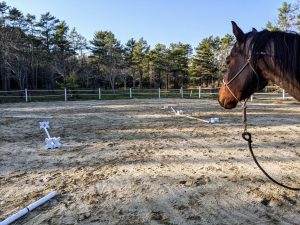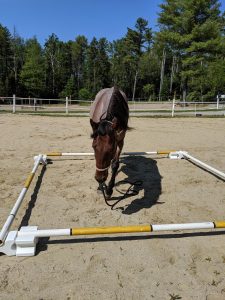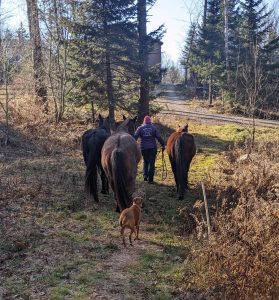Editor’s Note: Julie Kenney is an avid horsewoman, former Best Horse Practices Summit board member, and runs Blackberry Farm in Harpswell, Maine. She shares this multi-part reflection of work with three horses.
Julie writes:
Joe came to me at a time of upheaval in my horse life, during the fall of 2020. My older horse, Eli was coming up lame more often, as I wrote about here. Various treatments weren’t having any long-term success and I was feeling very sad at losing my riding partner. It was time to find a new mount.
 At this same time, in the midst of a global pandemic, my husband and I wanted to upgrade our horse trailer so that we could go camping, too. Along comes an ad for just the sort of trailer we were looking for. It was being sold by a friend we used to barrel race with. Getting ready to purchase our trailer, I poured out my anguish over “losing” my long-time riding partner and needing to look for a younger horse that I could finish training and who also had a good mind. Through God’s amazing grace, my friend had just the possible horse at her place that she hadn’t even planned to sell yet.
At this same time, in the midst of a global pandemic, my husband and I wanted to upgrade our horse trailer so that we could go camping, too. Along comes an ad for just the sort of trailer we were looking for. It was being sold by a friend we used to barrel race with. Getting ready to purchase our trailer, I poured out my anguish over “losing” my long-time riding partner and needing to look for a younger horse that I could finish training and who also had a good mind. Through God’s amazing grace, my friend had just the possible horse at her place that she hadn’t even planned to sell yet.
Then I met him, a 3-1/2 year old that had 90 days professional training the spring before. We saddled, bridled, and walked him along a busy road to their arena. He was calm, relaxed, interested in his surroundings, in tune with his rider, and I had the biggest smile on my face and in my heart as I rode him. He wasn’t mentally stressed out from hard training, his body hadn’t been overworked or strained, but he just wasn’t “cow-y” or competitive enough for the owner, who now loves to team pen.
That afternoon I hauled home my new trailer, with a new horse.
We took him on trails, at home and away. I found him still awkward at balancing a lope, which is expected at his age and level of training. Joey was just what I was looking for in a new riding partner.
 Then he was diagnosed with Lyme disease and Anaplasmosis, another tick-borne disease.
Then he was diagnosed with Lyme disease and Anaplasmosis, another tick-borne disease.
By then it was late fall. Joey responded well to his treatment so I left him to just be a horse with his new herd for the winter. He has a young soul, trying to get everyone to play with him, a little mouthy, curious about everything and everyone, and just a sweetheart to work with.
Now 4 years old, Joe’s training includes in-hand work and light saddle work. Some stretching and basic massage has also helped. He is quick to pick up new exercises that I introduce to him, like leading him by each individual foot using a rope.
I like that Joey is a blank slate with which I can continue his education. I do have to keep an eye out for any hind-end stiffness or swelling, all recurring tick disease issues. Tragically, it is kind of funny that I bought Joe because my previous saddle horse was dealing with chronic lameness. At least now I know what to watch for and to treat.
Joey isn’t going anywhere; he is a solid member of my herd. He is here to stay, to develop him into the best horse he can be. I’m looking forward to continuing his education, into a horse that anyone would enjoy riding.
NEXT:
- As with Hank and Eli, Joey should benefit from the massage techniques in Jim Masterson’s book.
- There may be other therapies that he would benefit from, so I will search them out as needed.
- I will also be taking video lessons with Amy Skinner to help us be the best saddle horse and rider that we can be.
 As you have read, all three horses require similar rehabilitation and training, even though they are very different in ages and training backgrounds. Certain exercises will be more beneficial for one horse or the other, but all the exercises will help.
As you have read, all three horses require similar rehabilitation and training, even though they are very different in ages and training backgrounds. Certain exercises will be more beneficial for one horse or the other, but all the exercises will help.
The largest challenge before me is winter on the Maine coast. With changes in the climate, we are experiencing much more freezing rain than snowfall, or, ice followed by a light coating of snow (which I find more dangerous as you cannot tell where it’s icy underneath). Riding here means dealing with icy hills to get anywhere. The same goes for hauling out our driveway, which is also hilly, to head to a nearby rented indoor arena. We can use salted sand to coat the ground, but it’s still risky to load up a horse.
The herd lives outdoors 24/7 except for prolonged icy rain or significant snowfall events. They each have a box stall that is open to the outdoors as well as to each other. In addition to their stalls, I have a narrow barn aisle that I use for massages, stretching, standing on the unstable gym mat, and other techniques that don’t require a lot of movement.
I am committed to working with each of the horses at least four times per week, as Jec Ballou encourages us if we want to see progress in our horse’s physical health. That way, once riding is safe to do, we won’t be starting back at Square One.
So this amateur trainer says, “So long and happy training—I’m off to work with my horses.”